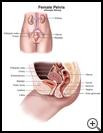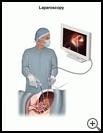
Oophorectomy (Removal of Ovaries)
What is an oophorectomy?
Oophorectomy is surgery to remove one ovary or both ovaries. The ovaries are part of the female reproductive system. They make and store eggs and the female hormones estrogen and progesterone. There are many reasons why you might need to have an ovary removed. You may have endometriosis, cysts, or tumors on the ovary, or scar tissue (adhesions) of the ovary. The ovary may be infected or have other problems. Some women have their ovaries removed because they are at high risk for ovarian cancer.
Depending on the reason for the surgery, you may have one ovary removed (unilateral oophorectomy) or both ovaries removed (bilateral oophorectomy). If both ovaries are removed you cannot become pregnant, and menopause will start right away. The fallopian tubes may be removed with the ovaries in a procedure called a salpingo-oophorectomy. If the ovaries are removed with the uterus, the procedure is a total hysterectomy.
How is an oophorectomy done?
Before the procedure:
- Your healthcare provider will ask you to sign a consent form for an oophorectomy. The consent form will state the reason you are having the procedure, what happens during the procedure, and what you may expect afterward.
- There is risk with every treatment or procedure. Talk to your healthcare provider for complete information about whether any of these risks apply to you:
- Anesthesia problems
- Bleeding
- Blood clots
- Infection
- Tell your healthcare provider if you have any food, medicine, or other allergies such as latex.
- Tell your healthcare provider if you are taking any medicines, including nonprescription drugs, herbal remedies, or recreational or illegal drugs.
- You will have a needle (IV) inserted into a vein in your hand or arm. This will allow for medicine to be given into your blood system and to give you fluids.
During the procedure:
- You may be given a sedative through your IV to help you to relax.
- You will be given medicines to prevent pain during your surgery. These may include:
- Regional anesthesia, which numbs a large area of your body. Depending on the medicine, you may be awake or asleep during the procedure.
- General anesthesia, which relaxes your muscles and puts you into a deep sleep. It also keeps you from remembering the operation. While you are asleep, you will have a tube in your throat to help you breath and to make sure you are getting enough oxygen. The tube may be removed before you wake up after the surgery.
- You may have a small tube (catheter) placed into your bladder to drain and measure urine.
- Your surgeon will recommend the best surgery for you. The type of surgery you have to remove the ovaries may be one of the following:
- Laparoscopic oophorectomy: Surgery to remove one or both ovaries through several small cuts on the lower abdomen
- Abdominal oophorectomy: Surgery to remove one or both ovaries through a large cut on the lower abdomen
- Your provider will then close the cut or cuts with stitches or staples.
- Temporary drains may be left in the cut so blood and fluid can drain.
After the procedure:
- You will be checked often by nursing staff.
- Your blood oxygen level will be monitored by a sensor that is attached to your finger or earlobe.
- Your heart rate, blood pressure, and temperature will be checked regularly.
- Your provider may prescribe medicines to:
- Treat pain
- Treat or prevent an infection
- Treat or prevent side effects, such as nausea or constipation, from other treatments
- Soften stool and reduce straining with a bowel movement
- Relieve symptoms of menopause when your ovaries are removed
- Your provider may recommend other types of therapy to help relieve pain, other symptoms, or side effects of treatment.
What can I do to help?
- You will need to tell your healthcare team if you have new or worsening:
- Dizziness
- Shortness of breath
- Pain or cramping in your belly
- Diarrhea, constipation, pain with bowel movements, or other intestinal problems
- Trouble emptying your bladder
- Heavy vaginal bleeding
- Vaginal discharge with a bad odor or itching
- Redness, swelling, pain, warmth, or drainage from your surgical wound
- Fever, chills, or muscle aches
- Ask questions about any medicine or treatment or information that you do not understand.
How long will I be in the hospital?
How long you will need to stay in the hospital depends on many factors. The average amount of time to stay in the hospital after an oophorectomy is 3 days.
Last modified: 2016-02-08
Last reviewed: 2016-07-15


